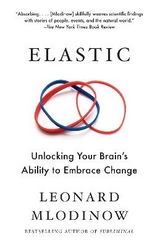
Elastic
Pantheon Books (Verlag)
978-0-375-71524-2 (ISBN)
- Titel erscheint in neuer Auflage
- Artikel merken
"Elastic is a book that will help you survive the whirlwind."
-Daniel H. Pink, author of When and A Whole New Mind
Named to the 800-CEO-READ Business Book Awards Longlist
In this startling and provocative look at how the human mind deals with change, Leonard Mlodinow shows us to unleash the natural abilities we all possess so we can thrive in dynamic and troubled times. Truly original minds capitalize when everyone else struggles. And most of us assume that these abilities are innate, reserved for a select few. But Mlodinow reveals that we all possess them, that we all have encoded in our brains a skill he terms elastic thinking-and he guides us in how to harness it.
Drawing on groundbreaking research, Mlodinow outlines how we can learn to let go of comfortable ideas and become accustomed to ambiguity and contradiction; how we can rise above conventional mindsets and reframe the questions we ask; and how we can improve our ability to solve problems and generate new ideas-critical skills for achieving professional and personal success in our quickly morphing world.
LEONARD MLODINOW's previous books include the best sellers Subliminal (winner of the PEN/E. O. Wilson Literary Science writing award), The Drunkard's Walk (a New York Times Notable Book), War of the Worldviews (with Deepak Chopra), and The Grand Design (with Stephen Hawking), as well as The Upright Thinkers, Feynman's Rainbow, and Euclid's Window. He also wrote for the television series MacGyver and Star Trek: The Next Generation. leonardmlodinow.com
Introduction The Demands of Change On July 6, 2016, Niantic, a forty-person startup company founded by ex-employees of Google's "Geo" division, launched Pokémon Go, an "augmented reality" game that employs a phone's camera to let people capture virtual creatures that appear on their screens as if they exist in the real world. Within two days the app had been installed on more than 10 percent of all Android phones in the United States, and within two weeks it had thirty million users. Soon iPhone owners were spending more time each day on Pokémon Go than on Facebook, Snapchat, Instagram, or Twitter. Even more impressive, within days of the game's release, the words Pokémon Go drew more searches on Google than the word porn. If you're not a gamer, you might roll your eyes or shrug at all that, but in the business world, the events were hard to ignore: The game generated an astonishing $1.6 million in revenue each day from domestic Apple users alone. Just as important, it added $7.5 billion to Niantic's market value virtually overnight, and within a month it had doubled the stock price of Nintendo, the company that owns the Pokémon trademark. In its first six months of existence, more than six hundred million people downloaded the Pokémon Go app. Contrast that with some of the greatest successes of the early 2000s. Facebook launched in 2004, but it didn't hit the thirty-million-user mark until 2007. The hugely popular World of Warcraft game, also released in 2004, took six years to climb to its peak of twelve million subscribers. What seemed like pedal-to-the-metal growth back then became, ten years later, life in the slow lane. And though no one can predict what the next big new thing will be, most economists and sociologists expect that society will only continue to morph faster in the foreseeable future. But to focus only on the speed of Pokémon Go's ascent is to miss much of the point. The game's massive success might not have been predictable, but neither was it accidental. In creating the app, Niantic made a series of innovative and forward-thinking decisions concerning the use of technology, such as piggybacking on the GPS and camera capabilities of a cell phone and leveraging cloud computing to power the app, which provided a built-in infrastructure and a capacity to scale. The game also took advantage, like nothing before it, of app-store economics, a business model that hadn't even been invented when World of Warcraft launched. In that now familiar approach, a game is given away free of charge and makes its money by selling add-ons and upgrades. Maintaining that revenue stream was another challenge. In the interactive entertainment industry, a game can start out popular and still have the shelf life of raw oysters. To avoid that fate, Niantic surprised many with a long campaign to aggressively update the app with meaningful features and content. As a result, a year after its launch, 65 million people were still playing the game each month, and revenues had reached $1.2 billion. Before Pokémon Go, the conventional wisdom was that people didn't want a game that required physical activity and real-world interaction. And so, despite all the innovation in Silicon Valley, the Pokémon Go developers were often admonished that gamers just "want to sit and play." But the developers ignored that widely held assumption, and by leveraging existing technologies in a novel way, they changed the way game developers think. The flip side of the Pokémon Go story is that if your thinking is not deft, your company can quickly sink. Just look at BlackBerry, Blockbuster, Borders, Dell, Eastman Kodak, Encyclopaedia Britannica, Sun Microsystems, Sears, and Yahoo. And they are just the tip of the iceberg-in 1958, the average life span of companies in the S&P 500 was sixty-one years. Today it is about twenty. We have to face analogous intellectual challenges in our daily lives. Today we
| Erscheinungsdatum | 10.03.2018 |
|---|---|
| Sprache | englisch |
| Themenwelt | Sachbuch/Ratgeber ► Gesundheit / Leben / Psychologie ► Lebenshilfe / Lebensführung |
| Geisteswissenschaften ► Psychologie ► Allgemeine Psychologie | |
| Geisteswissenschaften ► Psychologie ► Verhaltenstherapie | |
| Naturwissenschaften ► Biologie ► Humanbiologie | |
| Naturwissenschaften ► Biologie ► Zoologie | |
| Wirtschaft ► Betriebswirtschaft / Management | |
| Schlagworte | ADHD • business • clarence saunders • Cognition • cognitive style • Creativity • Decision Making • Default network • Denken • divergent thinking • Entrepreneurship • Executive Functions • Innovation • integrative thinking • lateral prefrontal cortex • Left Brain • Marcus Raichle • Mary Shelley • mental fluency • Modern Technology • Moore's law • Nancy Andreasen • neophilia • Neuroscience • neuroscience of change • pattern recognition • Popular science • Problem Solving • Psychology • reward system • Richard Feynman • right brain • schizotypy • Silicon Valley |
| ISBN-10 | 0-375-71524-X / 037571524X |
| ISBN-13 | 978-0-375-71524-2 / 9780375715242 |
| Zustand | Neuware |
| Haben Sie eine Frage zum Produkt? |
aus dem Bereich



